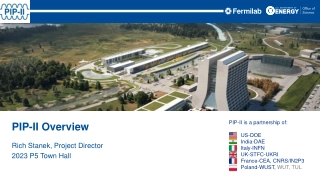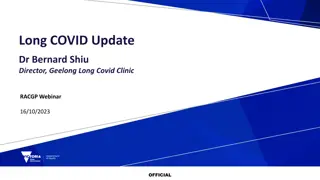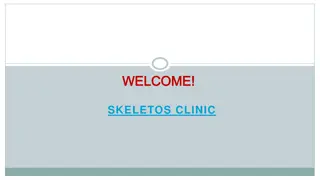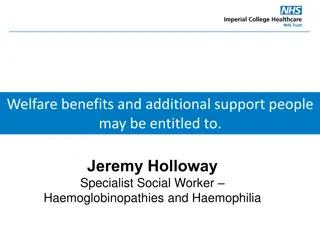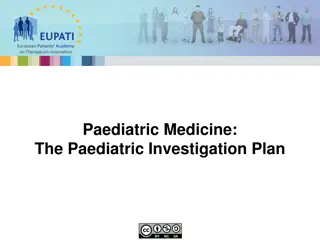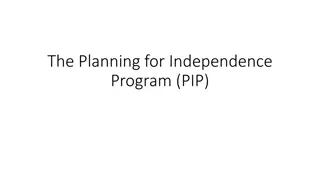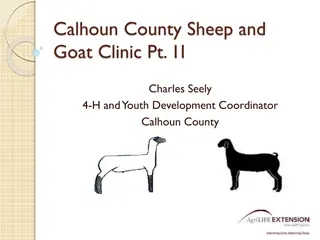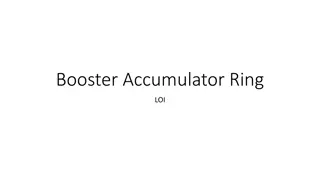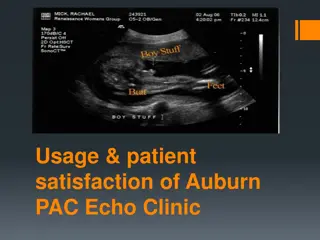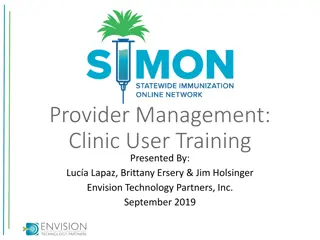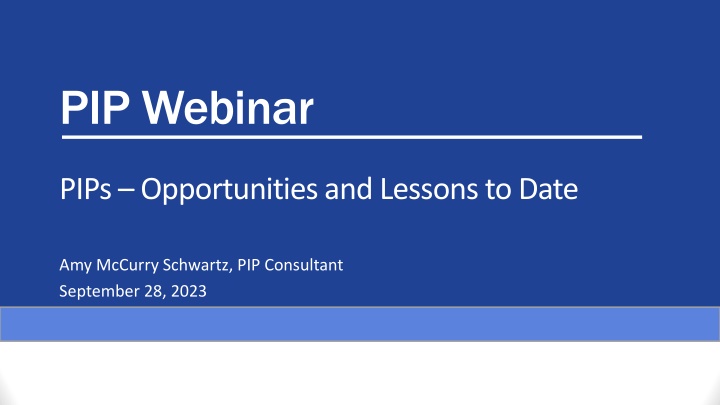
Opportunities and Lessons in PIPs: Insights from the Webinar
Explore the relationship between DHCS Behavioral Health Quality Improvement Program (BHQIP) Milestone 3d and CMS PIP requirements in this webinar. Learn about examples of progress, different PIP types, and Milestone 3d objectives. Understand the significance of PIP projects in achieving health outcomes and satisfaction for enrollees.
Download Presentation

Please find below an Image/Link to download the presentation.
The content on the website is provided AS IS for your information and personal use only. It may not be sold, licensed, or shared on other websites without obtaining consent from the author. If you encounter any issues during the download, it is possible that the publisher has removed the file from their server.
You are allowed to download the files provided on this website for personal or commercial use, subject to the condition that they are used lawfully. All files are the property of their respective owners.
The content on the website is provided AS IS for your information and personal use only. It may not be sold, licensed, or shared on other websites without obtaining consent from the author.
E N D
Presentation Transcript
PIP Webinar PIPs Opportunities and Lessons to Date Amy McCurry Schwartz, PIP Consultant September 28, 2023
Purpose of Todays Webinar Discuss the overlap/relationship between the DHCS Behavioral Health Quality Improvement Program (BHQIP) Milestone 3d and the CMS PIP requirements Discuss the September 2023 submission and Reporting Template Review examples of progress of BHQIP PIPs Review other PIP examples outside of the BHQIP PIPs
Introduction CalEQRO partnered with DHCS to align BHQIP Milestone 3d deliverables with federal Performance Improvement Project (PIP) requirements to support Behavioral Health Plan (BHP) efforts This alignment is available to all counties BHQIP Data Exchange deliverable requires baseline measurement and an implemented QI Plan to improve performance on three specified HEDIS measures
What is a PIP? CMS: A PIP is a project conducted by the BHP that is designed to achieve significant improvement, sustained over time, in health outcomes and enrollee satisfaction. A PIP may be designed to change behavior at a member, provider, and/or BHP/system level. Source: CMS External Quality Review (EQR) Protocols, October 2019, Protocol 1. Validation of Performance Improvement Projects, p. 27. DHCS requires that two active PIPs are in place during the preceding 12 months of a review.
Types of PIPs Non-clinical Clinical There is not an intervention that relates to the direct treatment of beneficiaries Reminder calls; texts; emails; newsletters; new scheduling system . At least one intervention relates to the direct treatment of beneficiaries At least one indicator that measures (or is a proxy for) a clinical outcome or impact Requires at least one beneficiary- level indicator There must be meaningful association with outcomes or improved care for beneficiaries
What is Milestone 3d? Milestone 3d deliverables require baseline measurement and an implemented QI Plan to improve performance on the following three HEDIS measures: Follow-up After Emergency Department Visit for Alcohol and Drug Abuse or Dependence (FUA) Follow-up After Emergency Department Visit for Mental Illness (FUM) Pharmacotherapy for Opioid Use Disorder (POD)
Participation in the BHQIP PIP is OPTIONAL Counties need to meet the requirements in the DHCS reporting templates to receive BHQIP incentive payments. Counties may submit the BHQIP Milestone 3d template(s) to CalEQRO for consideration as a PIP. Counties who submit the completed DHCS templates to DHCS but choose not to participate in the BHQIP PIP will still be responsible for two MHP PIPs (all counties) and two DMC-ODS PIPs (for DMC-ODS counties).
How MHPs Participate in the BHQIP PIP To be considered for a PIP, the BHP must submit the following, at the time of EQR document submission: For MHP PIP Credit: Completed Milestone 3d Template B (in lieu of the PIP Development tool) Evidence of PIP activity since last EQR, including activity since the Template was submitted to DHCS CalEQRO will review and validate the BHQIP PIP during the scheduled annual review process. CalEQRO may request additional information during the validation process.
How DMC-ODS Participate in the BHQIP PIP To be considered for a PIP, the BHP must submit the following, at the time of EQR document submission: For DMC-ODS PIP Credit: Completed Milestone 3d Template A and/or Template C (in lieu of the PIP Development tool) Evidence of PIP activity since last EQRO, including activity since the Template was submitted to DHCS CalEQRO will review and validate the BHQIP PIP during the scheduled annual review process. CalEQRO may request additional information during the validation process.
Validation of all DHCS submissions For CMS PIP credit the DHCS Milestone 3d Template A, B, C will be validated with the CalEQRO PIP Validation Tool All PIPs submitted for BHQIP credit will be validated according to CMS Protocol 1: Validating a Performance Improvement Project BHPs will be expected to submit any additional information as requested by CalEQRO to facilitate the competition of the Validation Tool
TEMPLATES A, B, C SECTIONS 1-5: COUNTY RESPONSIBILITY Q1: Problem Statement: what is the problem this performance improvement plan proposes to solve? Q18: Beneficiary Engagement: Address when and how beneficiaries will be engaged in the period prior to the next reporting period in 9/29/2023. Specifically address how beneficiaries will be engaged. Q2: What is the aim/goal for this performance improvement project? Q5 from September 2022 submission: Describe the beneficiary or enrollee population affected by the problem. n/a Q12: Key Performance Indicators (KPI), Future: Identify at least 2 key performance indicators that will be used to assess the implementation and success of each intervention (process or outcome, Science of Improvement: Establishing Measures) identified in Question 4 above during the upcoming reporting period. For each indicator, indicate target performance. These KPIs may (but do not have to) differ from those identified in Question 9 based on the Participating Entity s implementation plan. Provide performance metrics, including both outcome and process measures, relevant to the project. Describe how each intervention connects to these performance metrics.
TEMPLATES A, B, C VALIDATION TOOL SECTIONS 6-7: COUNTY RESPONSIBILITY SECTIONS 6-7: EQRO RESPONSIBILITY Section 6: Assess the Improvement Strategies (CMS Identifies this as Activity 1, Step 8) Q 4: State the selected intervention(s)for this quality improvement project (Reference: Submission for 9/30/2022, Question #10) Q5: Narrative Description of Changes: Briefly describe any revisions to selected interventions since the last submission for BHQIP. Address the reasons leading to any changes, as well as the data or evidence considered leading to these changes. Q7: Implementation Steps Completed: Describe steps completed as of 9/29/2023 to implement the interventions identified, including time periods or dates of action. (Reference: Submission for 9/30/2022,Question #12). Q12: Implementation Steps, Planning for the Future: Describe at least 3 concrete steps that the Participating Entity will carry forth in the following 6 months to implement the interventions specified in Question 4 and to assess performance on the key performance indicators specified in Question 12. Provide time frames or dates foreach step identified. Q15: Data Exchange Strategy: Identify and describe data exchange efforts between the Participating Entities and other stakeholders to identify beneficiaries eligible for treatment after presenting to an emergency department for alcohol use disorder or other substance use disorder and to assess performance via Key Performance Indicators and drive change towards its Aim Statement. (Reference: Submission for 9/30/2022, Question #17). Section 7: Review the Data Collection Procedures (CMS Identifies this as Activity 1, Step 6) Q16: Data Exchange, Narrative: Briefly describe the Participating Entity s experience since the last BHQIP submission regarding data exchange. Identify any challenges faced and lessons learned specific to the implementation of the improvement plan.
TEMPLATES A, B, C VALIDATION TOOL SECTIONS 8-9: COUNTY RESPONSIBILITY SECTIONS 8-9: EQRO RESPONSIBILITY Q13: Collaborations with Managed Care Plans: What collaborations has the Participating Entity engaged in with Managed Care Plan partners? DHCS requires that Behavioral Health Plans engage in good faith efforts collaborate with Managed Medi-Cal Plans. Section 8: Review Data Analysis and Interpretation of PIP Results (CMS Identifies this as Activity 1, Step 7) Q14: Collaborations with Health Care Delivery Partners: What collaborations has the Participating Entity engaged in with Health Care Delivery Partners (e.g. hospitals or clinics)? DHCS does not require but strongly encourages collaborative relationships of Participating Entities with health delivery partners Q19: Submission Checklist: Attest that the following DHCS requirements have been met for this Template at the time of submission. The below checklist is intended to help Entities to ensure the completeness of their submissions. DHCS will evaluate the submitted template holistically, with specific attention to the logical relationship between the Participating Entity s Problem Statement, Aim Statement, Selected Interventions, Completed Intervention Steps, Key Performance Indicators, Equity Analysis, Stakeholder Engagement, and Data Exchange. Section 9: Assess the Likelihood that Significant and Sustained Improvement Occurred
Relationship between EQR PIPs and BHQIP PIPs VALIDATION TOOL TEMPLATES A, B, C SECTIONS 10-11: EQRO RESPONSIBILITY Section 10: Perform Overall Validation and Reporting of PIP Results SECTIONS 10-11: COUNTY RESPONSIBILITY No county responsibility No county responsibility Section 11: Perform Overall Validation and Reporting of PIP Results
Timeline Implementation Remeasurement Analysis Closing Implementation Remeasurement Analysis Baseline Measurement & Planning
December 2022 PIP Clinic Topics Establishing a Problem Using Data Developing a Plan Root Cause Analysis Establishing Interventions Based on Root Cause Analysis
March 2023 PIP Clinic Topics Implementing interventions for BHQIP PIP based on Root Cause Analysis Developing Data Collection and Implementation plans Measuring the effectiveness of Interventions # of patients referred from ED to BHP # of referred patients who complete follow up appointment
June 2023 PIP Clinic Topics Intervention Review Collaboration and Barrier analysis involving the ED (FUM/FUA) Capacity to respond to referrals (FUM) Single point of contact for EDs (FUM) Further analysis for pinpoint intervention identification (FUM) Ensuring linkage to Data Exchange
September 2023 PIP Clinic Topics Template Updates Specific Examples of Changes made by BHPs in response to the update Review of FUA and POD PIPs Review of non-BHQIP PIP
BHQIP PIPs = BHQIP Goal 3, Milestone 3d BHQIP Goal 1: Payment Reform 3 Milestones BHQIP Goal 2: Implementation of CalAIM BH Policy Changes 5 Milestones BHQIP Goal 3: Data Exchange 4 Milestones Milestone 3d: Leverage improved data exchange capabilities to improve quality and coordination of care.
FUA Follow-up After Emergency Department Visit for Alcohol and Drug Abuse or Dependence (FUA) The percentage of emergency department (ED) visits for members 13 years of age and older with a principal diagnosis of alcohol or other drug (AOD) dependence, who had a follow up visit for AOD within 7 days and 30 days of being seen in the ED.
Revised Template: BHQIP Aim Statements DHCS is no longer requiring that Participating Entities calculate HEDIS measure performance rates for Goal 3 of BHQIP. DHCS encourages Counties to focus Aim Statements on quality improvement efforts to address associated Problem Statements, not HEDIS performance rate calculation. Counties may revise their Aim Statements to capture a scope of work that is narrower than a HEDIS measure. Participating Entities that change either or both their Problem Statement (Question 1) and Aim Statement (Question 2) must ensure that: The Problem Statement and Aim Statement are supported by the Participating Entity s Root Cause Analysis The Problem Statement and Aim Statement are logically related
FUA Problem Statement Revisions September 2022 problem statement: A majority of Medi-Cal patients discharged from the emergency department (ED) with a principal diagnosis of a substance use disorder (SUD) do not receive a follow-up treatment in a timeframe that evidence shows is necessary to reduce substance use, future ED use, or hospital admissions; and there are significant disparities among Spanish-speaking and Hispanic beneficiaries. Revised 2023 problem statement: Due to the absence of automated data exchange mechanisms and gaps in person- centered communication and coordination of care, the majority of Medi-Cal patients discharged from county emergency departments (ED) with a principal diagnosis of a substance use disorder (SUD) do not receive a follow-up treatment in a timeframe that evidence shows is necessary to reduce substance use, future ED use, and hospital admissions; and there are significant disparities among Spanish-speaking and Hispanic beneficiaries.
FUA Aim Statement Revisions September 2022 Aim Statement: By appointing a bilingual/bicultural ED liaison at BHS; implementing referral and linkage information exchange; and applying culturally relevant strategies to support beneficiaries linking to SUD services, County aims to achieve a 5% increase in 7-day and 30-day follow- up rates for all Medi-Cal as well as Spanish-speaking and Hispanic beneficiaries by June 30, 2023. Revised 2023 problem statement: By Q4 2023, DMC-ODS aims to increase by 5% over MY2021 baseline the percentage of all substance use disorder-related ED visits with 7-day and 30-day follow-up services (11.9% and 21.6%, respectively) and in particular, the percentage of Hispanic follow-ups (7.6% and 13.5%), by: a) contracting with County s Health Information Organization (HIO) to provide (1) real-time alerts for active DMC-ODS clients upon admission to ED and (2) daily reports of beneficiariesdischarged from the ED into the community with principal diagnoses of alcohol or other drugs (AOD) b) implementing follow-up procedures by appointed and trained BHS providers, and c) conducting closed-loop referrals.
FUA Aim Statement Revisions September 2022 Aim Statement: For Medi-Cal Beneficiaries with ED visits for alcohol or other drugs (AOD) and substance use disorder (SUD) conditions, implemented interventions will increase the percentage of follow-up for AOD and SUD with the DMC-ODS within 7 and 30 days by 5% by June 30, 2023. September 2023 Aim Statement: For Medi-Cal Beneficiaries with ED visits for alcohol or other drugs (AOD) and substance use disorder (SUD) conditions, implemented interventions will increase the percentage of follow-up for AOD and SUD with the DMC-ODS within 7 and 30 days by 5% by January 1, 2024.
Guidelines for all Aim Statements DHCS is asking for a SMART Aim Statement: Specific, Measurable, Achievable, Relevant, Time-Bound CalEQRO has always asked that Aim Statements include: Make the Statement: Obvious Simple Answerable The focus of the PIP The plan for improvement Description of who is being helped Goal Time frame
FUA Interventions September 2022 Interventions: 1. BHS s ED liaison. BHS will appoint a bilingual SUD liaison to serve as the DMC-ODS point person for the county s emergency departments. The liaison will reach out to and educate ED staff about the DMC-ODS network of providers; train the SUNs and social workers to complete ASAM screenings; and disseminate a one-page flier directing patients to the SUD liaison. 2. Referral transmission and tracking. The FUA Workgroup will identify and develop an efficient and user-friendly method for establishing a bidirectional electronic system that can send DMC-ODS referrals and discharge information to both BHS and SUNs and, if possible, notify SUNs and when an initial appointment has been made. 3. Employ the Equity and Empowerment Lens Toolkit. FUA Workgroup will recruit Spanish-speaking and Hispanic members from Santa Cruz and Watsonville areas and will conduct focus groups and key informant interviews with Spanish-speaking and Hispanic beneficiaries and service providers to reveal reasons these beneficiaries are less likely to receive SUD services following an ED visit.
FUA Intervention Revisions September 2023 Interventions: Closed Loop Referral Transmission: BHS will develop culturally responsive referral pathways and adopt the Unite Us referral platform, allowing ED substance use navigators (SUNs), social workers, and other staff to securely and rapidly refer consenting patients to the DMC-ODS, and enabling SUD care coordinators to, accept referrals, reach out to patients, and communicate referral status back to the hospitals. Real-time alerts upon ED admission for active DMC-ODS clients: CHIO will transmit ED admission data, including presenting complaint, for enrolled DMC- ODS clients to Avatar in real-time, permitting members of their care team to follow-up, potentially while their client is still in the ED. Daily discharge reports for all beneficiaries: To prevent beneficiaries from falling through the cracks, SCHIO will transmit a daily report of all Medi-Cal beneficiaries discharged from the ED into the community with SUD diagnoses.
FUA Performance Measures Intervention 1. Closed Loop Referral Transmission: Results 41 referrals; 18 (44%) Hispanic and 11 (27%) Spanish speakers Performance Measure or KPI # of SUD-related referrals transmitted from ED to DMC-ODS through Unite Us platform Goal/Target At least 1 referral in September followed by steady increase each month through December 2023. #/% of Unite Us referrals that were resolved within 30 days # of alerts that indicate an AOD-related concern upon admission 100% are resolved 2. Real-time alerts upon ED admission for active DMC-ODS clients: At least 1 admission alert that indicates an AOD-related concern upon admission (indicates that alert system is operationalized) #/% that have a documented follow-up attempt within 7 days of ED discharge 80% of clients with AOD-related ED admission receive follow-up attempt within 7 days At least 1 discharge report for an unserved beneficiary with a principal AOD diagnosis (indicates that discharge reporting system is operationalized) 3. Daily discharge reports for all beneficiaries: # of discharge reports for unserved beneficiaries with a principal AOD diagnosis #/% that have a documented follow-up attempt within 7 days of ED discharge 80% of unserved beneficiaries with AOD- related diagnosis at discharge receive follow-up attempt within 7 days Outcome: % of all beneficiaries, Hispanic, and Spanish-speakers who had a follow-up service within 7 and 30-days of ED discharge 5% increase over 2021 baseline for all beneficiaries and Hispanics using the HEDIS specifications (indicates ability to receive complete reports, including MCP follow-ups, from hospitals via SCHIO) 2021 HEDIS 2023 KPIs All All referrals Hispanic referrals Hispanic Spanish 7-day 12% 8% 12% 6% 10% 30-day 22% 14% 27% 28% 20%
FUA Performance Measures The % of clients who were discharged from the ED for AOD and SUD visits who received treatment within 7 and 30 days. o January 2021 December 2021 6% of individuals discharged from the ED for a mental health visit received a service within 7 days. 11% of individuals discharged from the ED for a mental health visit received a service within 30 days. o January 2022-September 2022 12.3% of individuals discharged from the ED for a mental health visit received a service within 7 days. 24% of individuals discharged from the ED for a mental health visit received a service within 30 days. Despite the fact that an ED Referral process is not implemented, County experienced over 5% increase for both KPIs. This could indicate that the follow-up services currently in place are contributing to a natural increase in access and DMC-ODS services are present and utilized in the county. This could also indicate that DBH could have a larger impact on this population with use of a referral process. Proposed KPIs: o Referral forms received/ED Visits for AOD and SUD= Rate of referral o Not implemented yet o Spanish-speaking person referrals received/ED visits for AOD and SUD= rate of referrals and equity analysis data o Not implemented yet
Example of non BHQIP PIP Aim Statement Will using a strengths-based approach to discharge from Outpatient treatment along with a follow up call after OP discharge result in an increase utilization of Lower Levels of Care including recovery services and care coordination in the next 12 months?
Example of non BHQIP PIP Interventions Corresponding Variable (Indicator) Date Intervention Began Frequency of Intervention # Intervention 1a. 1/18/2021 1b. 10/01/ 2021 1 1a. Follow up call and survey made by Program A Minimum 1 call after discharge (between 7-30 days) 1)Number of discharges 1b. Program A and Program B were added to PIP 2)Number of logged phone calls
Example of non BHQIP PIP Performance Measures Performance Measures (Outcomes) Target Improvement Rate Variables (Indicators) Goal Interventions Strength based follow up call and survey after discharge Increase Level of Care transitions 1.Number of individuals discharged from OP 1. Percentage of individuals who successfully transition to 1. Increase successful transition to Lower LOC by 5% 2.Log of individuals who receive follow up call and survey 2. Decrease Readmission to equal or higher LOC. 2. lower loc Readmission to equal or Higher LOC For Program A and Program B: 11 to 8 %. Program C: 16% to 13%
Example of non BHQIP PIP Results Statistically Statistically significant significant change in change in performance performance (Yes/No) (Yes/No) Specify P Specify P- -value 1st 1st Demonstrate Demonstrate d d performance performance improvemen improvemen t (Yes/No) t (Yes/No) 1st 1st Most Most recent recent Remeasure Remeasure Dates/Year Dates/Year Most recent Most recent Remeasure Remeasure sample size sample size and rate and rate Performance Performance Measure Measure Description Description Target Target Performance Performance Rate Rate Baseline Baseline Dates/Year Dates/Year Baseline Baseline sample size sample size and rate and rate Remeasur Remeasur e e Dates/Year Dates/Year Remeasure Remeasure sample size sample size and rate and rate value Yes No Yes No P-value: <.01 <.05 Other: PM 1. Average of readmission data for Program A 8% N=10/85 12% N=4/7 57% 6/22-6/23 N= 19/92 20% 1/21- 12/21 1/22- 6/22 Yes No Yes No P-value: <.01 <.05 Other: PM 2. Average of Transition to lower loc Program A 15% N=9/85 11% N=4/7 57% 6/22-6/23 N=7/92 1/21- 12/21 1/22- 6/22 7% Yes No Yes No P-value: <.01 <.05 Other: PM 3. Cal-Oms Discharges Left Before Completion Program A 50% N=50/74 68% N=15/23 65% 6/22-6/23 N=24/35 1/21/- 12/21 1/22- 6/22 69%
Example of non BHQIP PIP Results Statistically Statistically significant significant change in change in performance performance (Yes/No) (Yes/No) Specify P Specify P- - value value 1st 1st Demonstrat Demonstrat ed ed performance performance improvemen improvemen t (Yes/No) t (Yes/No) 1st 1st Most Most recent recent Remeasure Remeasure Dates/Year Dates/Year Most recent Most recent Remeasure Remeasure sample size sample size and rate and rate Performance Performance Measure Measure Description Description Target Target Performance Performance Rate Rate Baseline Baseline Dates/Year Dates/Year Baseline Baseline sample size sample size and rate and rate Remeasur Remeasur e e Dates/Year Dates/Year Remeasure Remeasure sample size sample size and rate and rate Yes No Yes No P-value: <.01 <.05 Other: PM 1. Average of readmission data for Program B 8 % N=20/182 11% N=66/271 24% 1/21- 12/21 1/22- 12/22 Yes No P-value: <.01 <.05 Other: PM 2. Average of Transition to lower loc Program B 3% N=0/182 0% N=11/271 4% Yes No 1/21- 12/21 1/22- 12/22 Yes No Yes No P-value: <.01 <.05 Other: PM 3. Cal-Oms Discharges Left Before Completion Program B 50% N= 104/182 57% 1/21- 12/21 1/22- 6/23 N=182/266 68%
Example of non BHQIP PIP Results Statistically Statistically significant significant change in change in performance performance (Yes/No) (Yes/No) Specify P Specify P- - value value Demonstrat Demonstrat ed ed performanc performanc e e improvemen improvemen t (Yes/No) t (Yes/No) 1st 1st 1st 1st Most Most recent recent Remeasure Remeasure Dates/Year Dates/Year Most recent Most recent Remeasure Remeasure sample size sample size and rate and rate Performance Performance Measure Measure Description Description Target Target Performance Performance Rate Rate Baseline Baseline Dates/Year Dates/Year Baseline Baseline sample size sample size and rate and rate Remeasur Remeasur e e Dates/Yea Dates/Yea r r Remeasure Remeasure sample size sample size and rate and rate Yes No Yes No P-value: <.01 <.05 Other: PM 1. Average of readmission data for Program C 13 % N=48/329 16% 1/21- 12/21 1/22- 12/22 N=101/318 37% Yes No Yes No P-value: <.01 <.05 Other: PM 2. Average of Transition to lower loc Program C 3% N=0/329 0% N=4/318 1% 1/21- 12/21 1/22- 12/22 Yes No P-value: <.01 <.05 Other: PM 3. Cal-Oms Discharges Left Before Completion 50% N= 275/341 80% Yes No 1/21- 12/21 1/22- 6/23 N= 270/405 67%
FUM Follow-up After Emergency Department Visit for Mental Illness (FUM) The percentage of emergency department (ED) visits for members 6 years of age and older with a principal diagnosis of mental illness, who had a follow-up visit for mental illness who had a follow up visit for AOD within 7 days and 30 days of being seen in the ED.
FUM Interventions Intervention for MHP: Develop a communication process and referral process from the ED, tracking ED referrals and collecting the data in Avatar, and forming a dedicated care team. The MHP began the intervention in February meeting with and posting informational fliers with ED staff promoting referrals. The MHP reports receiving a high volume of referrals that exceed staffing capacity. Number of successful data exchanges with MCP Number of successful data exchanges with HIE Percentage of beneficiaries with a MH condition receiving follow up services within 7 days post ED discharge (FUM7) Percentage of beneficiaries with a MH condition receiving follow up services within 30 days post ED discharge (FUM30)
FUM Interventions Intervention for MHP: The MHP has staff co-located within the ED. Their current ability to provide care coordination and follow-up services after discharge is built into the MHP system of care. The addition of collaboration between the MHP and MCP will enhance the current gap of communication for those currently not linked between the ED and MHP. - Number of referrals from the ED to BH through the referral tracking system and % complete - Number and percent of clients receiving follow-up services within 7 and 30 days of discharge from ED
FUM Performance Measures # of ED patient info requests to Care Navigator during business hours # of ED patient info requests made to Care Navigator during after-hours (inclusive of nights, weekends, and holidays) # of patients Open to SMHS at time of ED request # of patients Not Open to SMHS at time of ED request Total # of follow-up appts made by Care Navigator # of follow-up appts made by Care Navigator for ER patients Open to SMHS # of follow-up appts made by Care Navigator for ER patients Not Open to SMHS # of follow-up appts scheduled by Care Navigator that were attended by patient
POD Pharmacotherapy for Opioid Use Disorder (POD) The percentage of opioid use disorder (OUD) pharmacotherapy treatment events among members age 16 and older that continue for at least 180 days (6 months).
POD Problem Statement Due to gaps in care coordination for beneficiaries with complex biopsychosocial needs, in 2021, only a small minority of pharmacotherapy dispensing or administration events in had continuous enrollment for 180 days or more less than the state and significantly less than the national averages.
POD Aim Statement Revisions Original Aim Statement: Revised Aim Statement: By Quarter 4 of 2023, County Behavioral Health Service s (BHS) DMC-ODS plan will increase the percentage of new NTP treatment episodes that last at least 30 days by 5% over the CY 2022 baseline (i.e., from 66.2% to 69.5%) by assessing patient needs at intake as well as providing closed loop referrals. The goal of this performance improvement project is to increase the percentage of new OUD pharmacotherapy events that achieve the 180-day threshold to at least 15% by June 2023, by (1) assessing for care coordination needs; (2) embedding additional care coordinators in MAT clinics; and (3) leveraging SCHIO to improve referral processes and medical information sharing.
POD Interventions September 2022 Interventions: Assessing for care coordination needs using a Medication adherence survey. During the initial session, NTP counselors will assess the likelihood of medication adherence using a structured interview or a paper-based survey and collaborate with patients to identify motivations and barriers. Embedding additional care coordinators in MAT programs. County Community Health Centers prescribe buprenorphine at clinics and mobile sites throughout the county. DMC-ODS funded case managers will meet for case consultation with mental health clinicians from the Healing the Streets program and provide care coordination to patients at clinic sites or in the field, including in homeless encampments. Leveraging information technology to improve referral processes and medical information sharing. The POD Workgroup will work with the planning and technology consultants to determine the best platform for bidirectional referrals and referral tracking between NTP/MAT programs and SUD care coordination, recovery services, outpatient, residential programs, and Enhanced Care Management (ECM).
POD Intervention Revisions September 2023 Interventions: Assessing for community support needs using a Medication Maintenance Needs Assessment. During the initial session, using a structured interview protocol, the DMC-ODS s Narcotic Treatment Provider (NTP) counselors and patients will assess the likelihood of medication adherence; and identify barriers to maintenance and resources that support stability, including those available through the NTP program and those requiring external referrals. Providing closed-loop referrals. The paper-based assessment form includes a simple color-coded algorithm to help counselors propose appropriate referral destinations. Referral destinations include services delivered by other DMC-ODS programs, mental health services delivered by MHP programs, physical, dental, and mental health services provided through MCP programs, and other community-based resources. If patients consent, referrals will be made using the Unite Us platform.
POD Performance Measures Intervention 1: Assess for community support needs using a medication maintenance needs assessment (MMNA): full implementation KPI/Performance Measure Result COMPARISON TO EXPECTATION # and % of NTP admissions that received an MMNA assessment (August 2023) 23 admits participated in the MMNA (53%) This is a lower proportion than we hoped for, but it was the first month of full implementation # and % of MMNAs that demonstrated a client interest in at least one external resource not provided by NTP program (e.g., ECM, MH, other SUD, transportation, housing, employment, healthcare, dental) (August 2023) 19 surveys (86%) demonstrated interest in an external resource This is higher than we expected, demonstrating active client and counselor engagement in needs assessment


